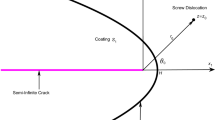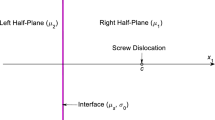Abstract
The aim of this work is to study the size-dependent elastic interaction of a screw dislocation with an elastic isotropic layered semi-infinite matrix using molecular dynamics analysis. The analytic solutions of complex functions of a screw dislocation in the matrix and in the thin layer are solved by means of applying complex potential approach in conjunction with the techniques of the image method. With the aid of the obtained stress fields and the Peach–Koehler formula, the explicit expressions for the image force acting on the screw dislocation are obtained. The results indicate that a large change in distance between dislocation and interface leads to a slight change in potential energy and stress. The material elastic dissimilarity, the thin layer thickness and the dislocation position play a crucial role in the image force acting on the dislocation. When a screw dislocation is in the matrix or in the layer, the image force approaches a constant value with the increasing thickness of thin layer. In addition, when the matrix is softer than the layer and the dislocation is in the matrix, there is a stable equilibrium position for dislocation; while, when the matrix is softer than the layer and the dislocation is in the layer, there exists a non-stable equilibrium position for dislocation.











Similar content being viewed by others
References
Freund LB (1987) The stability of a dislocation threading a strained layer on a substrate. J Appl Mech 54:553–557
Li J, Fang QH, Liu YW (2014) Elastic interaction between edge dislocation, concentrated force, point heat source and edge crack in a semi-infinite plane. Meccanica 49:493–502
Papanicolaou GC, Charitidis CA, Portan DV, Perivoliotis DK, Koklioti MA (2014) Investigation of nanomechanical properties of multilayered hybrid nanocomposites. Meccanica 49:2645–2655
Zhou ZG, Wang B (2006) An interface crack for a functionally graded strip sandwiched between two homogeneous layers of finite thickness. Meccanica 41:79–99
Chattopadhyay A, Gupta S, Kumari P, Sharma VK (2011) Propagation of torsional waves in an inhomogeneous layer over an inhomogeneous half-space. Meccanica 46:671–680
Tao YS, Fang QH, Zeng X, Liu YW (2014) Influence of dislocation on interaction between a crack and a circular inhomogeneity. Int J Mech Sci 80:47–53
Atashipour SA, Sburlati R, Atashipour SR (2014) Elastic analysis of thick-walled pressurized spherical vessels coated with functionally graded materials. Meccanica 49:2965–2978
Dong Q, Zhou K, Wei R, Luo J, Srikanth N (2015) Analysis of fluid pressure, interface stresses and stress intensity factors for layered materials with cracks and inhomogeneities under elastohydrodynamic lubrication contact. Int J Mech Sci 93:48–58
Schwarzer N, Richter F, Hecht G (1999) The elastic field in a coated half-space under Hertzian pressure distribution. Surf Coat Technol 114:292–304
Zhou K, Chen WW, Keer LM, Wang QJ (2009) A fast method for solving three-dimensional arbitrarily shaped inclusions in a half space. Comput Method Appl Mech Eng 198:885–892
Zhou K, Keer LM, Wang QJ (2011) Semi-analytic solution for multiple interacting three-dimensional inhomogeneous inclusions of arbitrary shape in an infinite space. Int J Numer Meth Eng 87:617–638
Kattis MA, Mavroyannis GD (2011) A unified two-phase potential method for elastic bi-material, planar interfaces. J Elast 103:73–94
Xu JQ, Mutoh Y (2003) Analytical solution for interface stresses due to concentrated surface force. Int J Mech Sci 45:1877–1892
Yang Z, Xu JQ (2009) Three-dimensional solution of concentrated forces in semi-infinite coating materials. Int J Mech Sci 51:424–433
Ranjith K (2014) Instabilities in dynamic anti-plane sliding of an elastic layer on a dissimilar elastic half-space. J Elast 115:47–59
Fang QH, Liu YW (2006) Size-dependent elastic interaction of a screw dislocation with a circular nanoinhomogeneity incorporating interface stress. Scr Mater 55:99–110
Zhou K, Nazarov AA, Wu MS (2007) Competing relaxation mechanisms in a disclinated nanowire: temperature and size effects. Phys Rev Lett 98:035501
Wu MS, Zhou K, Nazarov AA (2007) Crack nucleation at disclinated triple junctions. Phys Rev B 76:134105
Zhou K, Wu MS, Nazarov AA (2008) Relaxation of a disclinated tricrystalline nanowire. Acta Mater 56:5828–5836
Liu JX, Wang XQ (2004) Interaction of a screw dislocation with a notch in a piezoelectric bi-material. Arch Appl Mech 73:553–560
Wang X, Zhou K (2012) Novel near-cloaking multicoated structures for screw dislocations. Mech Mater 55:73–81
Wang X, Zhou K (2013) Misfit dislocation dipoles in coated fibrous composites. Mech Res Commun 52:88–91
Wu MS, Wang HY (2007) Solutions for edge dislocation in anisotropic film–substrate system by the image method. Math Mech Solids 12:183–212
Ma CC, Lee JM (2009) Theoretical analysis of generalized loadings and image forces in a planar magnetoelectroelastic layered half-plane. J Mech Phys Solids 57:598–620
Lee JM, Ma CC (2010) Analytical solutions for an anti-plane problem of two dissimilar functionally graded magnetoelectroelastic half-planes. Acta Mech 212:21–38
Zhou K, Wu MS (2010) Elastic fields due to an edge dislocation in an isotropic film-substrate by the image method. Acta Mech 211:271–292
Song HP, Gao CF (2012) The interaction between a screw dislocation and a rigid wedge inhomogeneity with an elastic circular inhomogeneity at the tip. Meccanica 47:1097–1102
Li J, Liu YW, Wen P (2014) An edge dislocation interacting with an elastic thin-layered semi-infinite matrix. Math Mech Solids 19:626–639
Petrova V, Sadowski T (2014) Theoretical modeling and analysis of thermal fracture of semi-infinite functionally graded materials with edge cracks. Meccanica 49:2603–2615
Plimpton S (1995) Fast parallel algorithms for short-range molecular dynamics. J Comput Phys 117:1–19
Li J, Fang Q, Liu Y, Zhang L (2014) A molecular dynamics investigation into the mechanisms of subsurface damage and material removal of monocrystalline copper subjected to nanoscale high speed grinding. Appl Surf Sci 303:331–343
Li J, Fang Q, Zhang L, Liu Y (2015) Subsurface damage mechanism of high speed grinding process in single crystal silicon revealed by atomistic simulations. Appl Surf Sci 324:464–474
Shim JH, Cho YW, Kwon SC, Kim WW, Wirth BD (2007) Screw dislocation assisted martensitic transformation of a bcc Cu precipitate in bcc Fe. Appl Phys Lett 90:021906
Shim JH, Kim DI, Jung WS, Cho YW, Hong KT, Wirth BD (2008) Atomistic study of temperature dependence of interaction between screw dislocation and nanosized bcc Cu precipitate in bcc Fe. J Appl Phys 104:083523
Shim JH, Kim DI, Jung WS, Cho YW, Wirth BD (2009) Strengthening of nanosized bcc Cu precipitate in bcc Fe: a molecular dynamics study. Mater Trans 50:2229–2234
Singh CV, Mateos AJ, Warner DH (2011) Atomistic simulations of dislocation–precipitate interactions emphasize importance of cross-slip. Scr Mater 64:398–401
Berendsen HJC, Postma JPM, van Gunsteren WF, DiNola A, Haak JR (1984) Molecular dynamics with coupling to an external bath. J Chem Phys 81:3684
Stukowski A (2010) Structure identification methods for atomistic simulations of crystalline materials. Model Simul Mater Sci Eng 18:015012–015018
Muskhelishvili NL (1975) Some basic problems of mathematical theory of elasticity. Noordhoff, Leyden
Hirth JP, Lothe J (1983) Theory of dislocations. McGraw-Hill, New York
Lee S (1987) The image force on the screw dislocation around crack of finite size. Eng Fract Mech 27:539–545
Li J, Fang Q, Liu Y (2013) Crack interaction with a second phase nanoscale circular inclusion in an elastic matrix. Int J Eng Sci 72:89–97
Li J, Fang Q, Liu Y (2014) Interface effects on elastic behavior of a screw dislocation around double nanowires. Phys B 442:6–11
Acknowledgments
The authors would like to deeply appreciate the support from the NNSFC (11172094, 11372103 and 11172095), the NCET-11-0122, the Hunan Provincial Science Fund for Distinguished Young Scholars (2015JJ1006), the Fok Ying-Tong Education Foundation, China (141005) and Interdisciplinary Research Project of Hunan University.
Author information
Authors and Affiliations
Corresponding author
Appendix 1
Appendix 1
When the screw dislocation is in the thin layer, the explicit expressions for the image force acting on the screw dislocation can be obtained. As shown in Fig. 6b, a screw dislocation is fixed at the distance d away from the surface, and the global coordinate is setted as originating at a screw dislocation. We also only need to study the image force of the y-direction force variation when a screw dislocation motives along the direction parallel with the y-axis. In addition, we can change the distance d to study a variation of the image force (\( z_{*} = 0 \)). The task now is to determine the complex potential in the layer under the boundary conditions described by Eqs. (1), (2) and (3).
Based on the work of Yang and Xu [14], by means of the image method, two series of infinite image points are produced from the screw dislocation point due to the surface and the interface. The first series of image points are illustrated in Fig. 12a, an image point is first produced by the interface and then reflected by the free surface, and so on. The image points reflected by the interface are denoted by \( O_{i} \), and the corresponding local coordinate is \( z_{k} \). The image points reflected by the free surface are denoted by \( C_{i} \), and the corresponding local coordinate is \( \zeta_{k} \). The relationships between the local coordinates and the global coordinates are
The second series of infinite image points are shown in Fig. 12b. First, an image point is produced by the free surface and then reflected by the interface, and so on. The image points reflected by the interface are denoted by \( A_{i} \), and the corresponding local coordinate is \( \eta_{k} \). The image points reflected by the free surface are denoted by \( B_{i} \), and the corresponding local coordinate is \( \xi_{k} \). The relationships between the local coordinates and the global coordinates are
When a screw dislocation with Burger’s vector \( b_{z} \) is located at an arbitrary point \( z_{*} \) in the layer, the complex potentials can take the following forms [16]
where the complex potential \( f_{\rm I} (z_{0} ) = \gamma \ln \left( {z - z_{*} } \right) \), γ = b z /(2πi) and \( z_{0} = z - z_{*} \). The complex potentials \( f_{\Pi } (z) \), \( a_{k} \left( {z_{k} } \right) \), \( b_{k} \left( {\zeta_{k} } \right) \), \( c_{k} \left( {\xi_{k} } \right) \), \( d_{k} \left( {\eta_{k} } \right) \), \( f_{k} \left( {z_{k} } \right) \) and \( g_{k} \left( {\eta_{k} } \right) \) are holomorphic in the regions where they are defined, respectively.
First, the continuity conditions should be satisfied along the interface. It is noted that at the interface one has \( z_{k} = \overline{{\zeta_{k} }} \) and \( \xi_{k + 1} = \overline{{\eta_{k} }} \). Substituting the stress functions expressed in Eqs. (23) and (24) into formula expressed in Eqs. (4) and (5) to obtain the stresses and the displacements, then into the continuity conditions of Eqs. (1) and (2), at the mean time considering the corresponding relationships of the image points, it yields
where the shear modulus ratio \( \Gamma _{2} = \mu_{2} /\mu_{1} \).
Based on interchange theorem, at the interface, we have
where L and R represent the left- and right-hand side of an equation like \( L(x,y) = R(x,y) \), respectively. Using Eq. (26), from Eq. (25) we can obtain
Second, at the free surface \( z_{k + 1} = \overline{{\zeta_{k} }} \) and \( \xi_{k} = \overline{{\eta_{k} }} \).
Based on interchange theorem, at the interface, we have
Using Eq. (29), from Eq. (28) we can obtain
According to Eqs. (23), (27) and (30), the displacement boundary conditions and the stress boundary conditions should be satisfied along the interface and the free surface, the complex potential function can be expressed as
Rights and permissions
About this article
Cite this article
Li, J., Fang, Q. & Liu, Y. Size-dependent elastic interaction of screw dislocations with semi-infinite coating materials revealed by atomistic simulation and two dimensional analysis. Meccanica 50, 2063–2075 (2015). https://doi.org/10.1007/s11012-015-0135-y
Received:
Accepted:
Published:
Issue Date:
DOI: https://doi.org/10.1007/s11012-015-0135-y





